Astronomers are continuing to unravel the mystery of deep space signals after discovering a never-before-seen quirk in a newly-detected Fast Radio Burst (FRB).
FRBs are millisecond-long, extremely bright flashes of radio light that generally come from outside our Milky Way galaxy. Most happen only once but some “repeaters” send out follow-up signals, adding to the intrigue surrounding their origin.
A new study published in the Monthly Notices of the Royal Astronomical Society has now shed new light on them, after spotting a “highly active” repeating FRB signal that is behaving differently to anything ever detected before.
Scientists at the SETI Institute in California recorded 35 FRBs from one source, FRB 20220912A, over a period of two months and found that a fascinating pattern emerged.
Like most repeating FRBs, each burst drifted from higher to lower frequencies over time.
But with FRB 20220912A there was also a never-before-seen drop in the centre frequency of the bursts, revealing what sounds like a cosmic slide-whistle when converted into a sonification using notes on a xylophone.
In it, most of the highest notes can be heard in the first few seconds and the majority of the lowest ones in the final seconds, as if the xylophone player is repeatedly hitting the lowest available bar on the instrument.
Astronomers think at least some FRBs are generated by a type of neutron star known as a magnetar – the highly magnetized cores of dead stars – while other theories point the finger at colliding neutron star binaries or merging white dwarfs.
“This work is exciting because it provides both confirmation of known FRB properties and the discovery of some new ones,” said lead author Dr Sofia Sheikh, of the SETI Institute.
“We’re narrowing down the source of FRBs, for example, to extreme objects such as magnetars, but no existing model can explain all of the properties that have been observed so far.”
The researchers made their discovery after carrying out 541 hours of observations using the SETI Institute’s Allen Telescope Array (ATA).
They also tried to identify a pattern in the timings between the bursts but none was found, further illustrating the unpredictable and mystifying nature of these intense blasts of radio waves.
Nevertheless, the latest research is another step forward in the quest to unlock the secrets of FRBs, which generate as much energy in a thousandth of a second as our Sun does in an entire year.
“It has been wonderful to be part of the first FRB study done with the Allen Telescope Array (ATA) – this work proves that new telescopes with unique capabilities, like the ATA, can provide a new angle on outstanding mysteries in FRB science,” Dr Sheikh added.
Media contacts
Rebecca McDonald
Director of Communications
SETI Institute
rmcdonald@seti.org
Robert Massey
Royal Astronomical Society
Mob: +44 (0)7802 877699
press@ras.ac.uk
Sam Tonkin
Royal Astronomical Society
Mob: +44 (0)7802 877700
press@ras.ac.uk
Science contacts
Dr Sofia Sheikh, Postdoctoral Fellow at the SETI Institute
ssheikh@seti.org
Multimedia and captions
Supplied animated gif: https://ras.ac.uk/media/1478
Animation of discovery plots for the 35 FRBs, shown in chronological order. The gradual shift towards the bottom of the observing window can be seen in the dedispersed frequency vs. time plot (top reddish subplot).
Sonification: https://ras.ac.uk/media/1481
This sound bite is a data sonification of the 101 sub-bursts observed with the ATA and analysed in this work. The centre frequency of each sub-burst is mapped to a xylophone note [in a one-octave A Lydian scale]. There is a lot of scatter in the notes, but most of the highest notes appear in the first few seconds, and most of the lowest notes appear in the last few seconds, as if the xylophone player is hitting the lowest available bar on the instrument repeatedly. We use statistical methods to verify that this trend from high to low is significant, and would likely continue if the ATA could observe at even lower frequency ranges (equivalent to ‘adding more notes’ at the bottom of the xylophone).
Further information
The new work appears in “Characterization of the Repeating FRB 20220912A with the Allen Telescope Array”, Sofia Z. Sheikh et al., Monthly Notices of the Royal Astronomical Society, in press.
A pre-print paper is available on arXiv at https://arxiv.org/pdf/2312.
Notes for editors
The Royal Astronomical Society (RAS), founded in 1820, encourages and promotes the study of astronomy, solar-system science, geophysics and closely related branches of science. The RAS organises scientific meetings, publishes international research and review journals, recognises outstanding achievements by the award of medals and prizes, maintains an extensive library, supports education through grants and outreach activities and represents UK astronomy nationally and internationally. Its more than 4,000 members (Fellows), a third based overseas, include scientific researchers in universities, observatories and laboratories as well as historians of astronomy and others.
The RAS accepts papers for its journals based on the principle of peer review, in which fellow experts on the editorial boards accept the paper as worth considering. The Society issues press releases based on a similar principle, but the organisations and scientists concerned have overall responsibility for their content.
Keep up with the RAS on X, Facebook, Instagram, LinkedIn and YouTube.
Download the RAS Supermassive podcast


